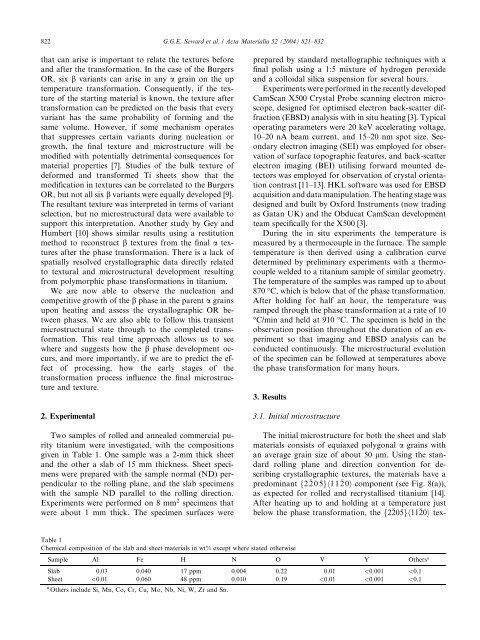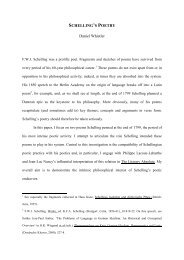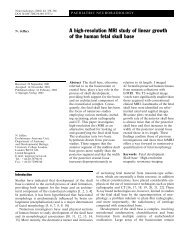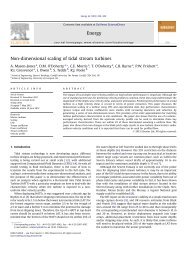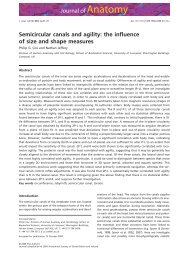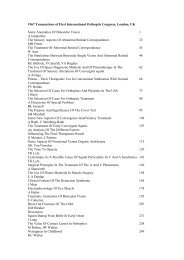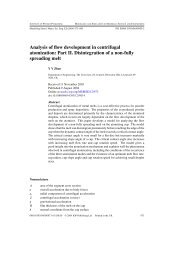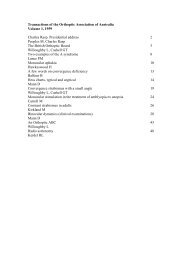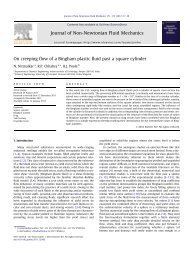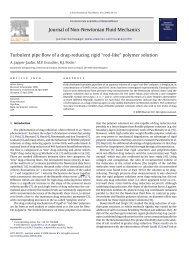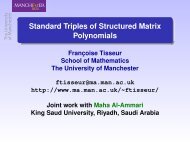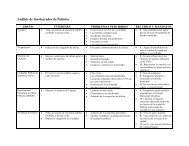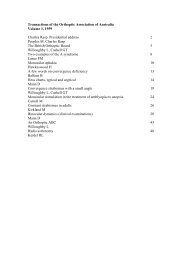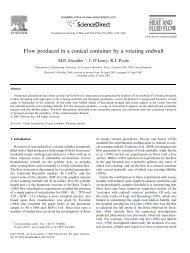In situ SEM-EBSD observations of the hcp to bcc phase ...
In situ SEM-EBSD observations of the hcp to bcc phase ...
In situ SEM-EBSD observations of the hcp to bcc phase ...
You also want an ePaper? Increase the reach of your titles
YUMPU automatically turns print PDFs into web optimized ePapers that Google loves.
822 G.G.E. Seward et al. / Acta Materialia 52 (2004) 821–832that can arise is important <strong>to</strong> relate <strong>the</strong> textures beforeand after <strong>the</strong> transformation. <strong>In</strong> <strong>the</strong> case <strong>of</strong> <strong>the</strong> BurgersOR, six b variants can arise in any a grain on <strong>the</strong> uptemperature transformation. Consequently, if <strong>the</strong> texture<strong>of</strong> <strong>the</strong> starting material is known, <strong>the</strong> texture aftertransformation can be predicted on <strong>the</strong> basis that everyvariant has <strong>the</strong> same probability <strong>of</strong> forming and <strong>the</strong>same volume. However, if some mechanism operatesthat suppresses certain variants during nucleation orgrowth, <strong>the</strong> final texture and microstructure will bemodified with potentially detrimental consequences formaterial properties [7]. Studies <strong>of</strong> <strong>the</strong> bulk texture <strong>of</strong>deformed and transformed Ti sheets show that <strong>the</strong>modification in textures can be correlated <strong>to</strong> <strong>the</strong> BurgersOR, but not all six b variants were equally developed [9].The resultant texture was interpreted in terms <strong>of</strong> variantselection, but no microstructural data were available <strong>to</strong>support this interpretation. Ano<strong>the</strong>r study by Gey andHumbert [10] shows similar results using a restitutionmethod <strong>to</strong> reconstruct b textures from <strong>the</strong> final a texturesafter <strong>the</strong> <strong>phase</strong> transformation. There is a lack <strong>of</strong>spatially resolved crystallographic data directly related<strong>to</strong> textural and microstructural development resultingfrom polymorphic <strong>phase</strong> transformations in titanium.We are now able <strong>to</strong> observe <strong>the</strong> nucleation andcompetitive growth <strong>of</strong> <strong>the</strong> b <strong>phase</strong> in <strong>the</strong> parent a grainsupon heating and assess <strong>the</strong> crystallographic OR between<strong>phase</strong>s. We are also able <strong>to</strong> follow this transientmicrostructural state through <strong>to</strong> <strong>the</strong> completed transformation.This real time approach allows us <strong>to</strong> seewhere and suggests how <strong>the</strong> b <strong>phase</strong> development occurs,and more importantly, if we are <strong>to</strong> predict <strong>the</strong> effect<strong>of</strong> processing, how <strong>the</strong> early stages <strong>of</strong> <strong>the</strong>transformation process influence <strong>the</strong> final microstructureand texture.2. ExperimentalTwo samples <strong>of</strong> rolled and annealed commercial puritytitanium were investigated, with <strong>the</strong> compositionsgiven in Table 1. One sample was a 2-mm thick sheetand <strong>the</strong> o<strong>the</strong>r a slab <strong>of</strong> 15 mm thickness. Sheet specimenswere prepared with <strong>the</strong> sample normal (ND) perpendicular<strong>to</strong> <strong>the</strong> rolling plane, and <strong>the</strong> slab specimenswith <strong>the</strong> sample ND parallel <strong>to</strong> <strong>the</strong> rolling direction.Experiments were performed on 8 mm 2 specimens thatwere about 1 mm thick. The specimen surfaces wereprepared by standard metallographic techniques with afinal polish using a 1:5 mixture <strong>of</strong> hydrogen peroxideand a colloidal silica suspension for several hours.Experiments were performed in <strong>the</strong> recently developedCamScan X500 Crystal Probe scanning electron microscope,designed for optimised electron back-scatter diffraction(<strong>EBSD</strong>) analysis with in <strong>situ</strong> heating [3]. Typicaloperating parameters were 20 keV accelerating voltage,10–20 nA beam current, and 15–20 nm spot size. Secondaryelectron imaging (SEI) was employed for observation<strong>of</strong> surface <strong>to</strong>pographic features, and back-scatterelectron imaging (BEI) utilising forward mounted detec<strong>to</strong>rswas employed for observation <strong>of</strong> crystal orientationcontrast [11–13]. HKL s<strong>of</strong>tware was used for <strong>EBSD</strong>acquisition and data manipulation. The heating stage wasdesigned and built by Oxford <strong>In</strong>struments (now tradingas Gatan UK) and <strong>the</strong> Obducat CamScan developmentteam specifically for <strong>the</strong> X500 [3].During <strong>the</strong> in <strong>situ</strong> experiments <strong>the</strong> temperature ismeasured by a <strong>the</strong>rmocouple in <strong>the</strong> furnace. The sampletemperature is <strong>the</strong>n derived using a calibration curvedetermined by preliminary experiments with a <strong>the</strong>rmocouplewelded <strong>to</strong> a titanium sample <strong>of</strong> similar geometry.The temperature <strong>of</strong> <strong>the</strong> samples was ramped up <strong>to</strong> about870 °C, which is below that <strong>of</strong> <strong>the</strong> <strong>phase</strong> transformation.After holding for half an hour, <strong>the</strong> temperature wasramped through <strong>the</strong> <strong>phase</strong> transformation at a rate <strong>of</strong> 10°C/min and held at 910 °C. The specimen is held in <strong>the</strong>observation position throughout <strong>the</strong> duration <strong>of</strong> an experimentso that imaging and <strong>EBSD</strong> analysis can beconducted continuously. The microstructural evolution<strong>of</strong> <strong>the</strong> specimen can be followed at temperatures above<strong>the</strong> <strong>phase</strong> transformation for many hours.3. Results3.1. <strong>In</strong>itial microstructureThe initial microstructure for both <strong>the</strong> sheet and slabmaterials consists <strong>of</strong> equiaxed polygonal a grains withan average grain size <strong>of</strong> about 50 lm. Using <strong>the</strong> standardrolling plane and direction convention for describingcrystallographic textures, <strong>the</strong> materials have apredominant f2 205gh11 20i component (see Fig. 8(a)),as expected for rolled and recrystallised titanium [14].After heating up <strong>to</strong> and holding at a temperature justbelow <strong>the</strong> <strong>phase</strong> transformation, <strong>the</strong> f2 205gh11 20i tex-Table 1Chemical composition <strong>of</strong> <strong>the</strong> slab and sheet materials in wt% except where stated o<strong>the</strong>rwiseSample Al Fe H N O V Y O<strong>the</strong>rs aSlab 0.03 0.040 17 ppm 0.004 0.22 0.01


